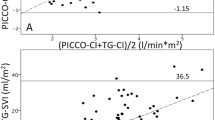Abstract
The performance of a reflection pulse oximeter and a transmission pulse oximeter was assessed during open-heart surgery when cardiac output, peripheral temperature, pulse pressure, and systolic pressure were low and vascular resisance was high. Before and after extracorporeal circulation (ECC) there was no difference in ability of the sensors to obtain readings and no difference in the accuracy of those readings. During partial ECC, especially after coronary artery bypass grafting, the reflection sensor gave readings earlier and at a lower pulse pressure. In addition, the transmission sensor failed to give any readings for 2 patients on partial ECC, for whom the reflection sensor did give readings. The accuracy of heart rate (HR) data was comparable for both sensors before ECC: however, during partial ECC, the reflection sensor tended to give values closer to the electrocardiographic HR. The accuracy of saturation data given by the reflection oximeter was comparable to that of the transmission oximeter. It is concluded that the accuracy of the saturation and HR data provided by the two methods of pulse oximetry are comparable, but that the reflection sensor is more likely to obtain readings under conditions of poorer peripheral circulation.
Similar content being viewed by others
References
Severinghaus JW, Naifeh KH, Koh SO. Errors in 14 pulse oximeters during profound hypoxia. J Clin Monit 1989;5:72–81
Severinghaus JW, Naifeh KH. Accuracy of response of six pulse oximeters to profound hypoxia. Anesthesiology 1987;67:551–558
Taylor MB, Whitwam JG. The accuracy of pulse oximeters. A comparative clinical evaluation of five pulse oximeters. Anaesthesia 1988;43:229–232
Yelderman M, New W. Evaluation of pulse oximetry. Anesthesiology 1983;59:349–352
Desiderio DP, Wong G, Shah NK, et al. A clinical evaluation of pulse oximetry during thoracic surgery. J Cardiothorac Anesth 1990;4:30–34
Mihm FG, Halperin BD. Noninvasive detection of profound arterial desaturation using pulse oximetry device. Anesthesiology 1985;62:85–87
Ridley SA: A comparison of two pulse oximeters. Anaesthesia 1988;43:136–140
Tremper KK, Hufstedler SM, Barker SJ, et al. Accuracy of a pulse oximeter in the critically ill adult: effect of temperature and hemodynamics. Anesthesiology 1985;63:A175
Alexander CM, Teller LE, Gross JB. Principles of pulse oximetry: theoretical and practical considerations. Anesth Analg 1989;68:368–376
Wilkins CJ, Moores M, Hanning CD. Comparison of pulse oximeters: effects of vasoconstriction and venous engorgement. Br J Anaesth 1989;62:439–444
Pälve H, Vuori A. Pulse oximetry during low cardiac output and hypothermia states immediately after open heart surgery. Crit Care Med 1989;17:66–69
Striebel HW, Steinhoff U, Krause H, Kretz FJ. Die Zuverlässigkeit der pulsoximetrischen Überwachung der arteriellen Sauerstoffsättigung bei zentralisierten und hypothermen Patienten. Anästh Intensivther Notfallmed 1988;23:200–204
Pälve H, Vuori A. Accuracy of three pulse oximeters at low cardiac index and peripheral temperature. Crit Care Med 1991 (in press)
Rosenberg J, Pederson MJ, Dahl JB. Discrepancy between finger and nasal pulse oximetry. Crit Care Med 1990;18:582
Jobes DR, Nicolson SC. Monitoring of arterial hemoglobin oxygen saturation using a tongue sensor. Anesth Analg 1988;67:186–188
Hickerson W, Morell M, Cicala RS. Glossal pulse oximetry. Anesth Analg 1989;69:72–74
Mendelson Y, Cheung PW, Neuman MR. Spectrophotometric investigation of pulsatile blood flow for transcutneous reflectance oximetry. Adv Exp Med Biol 1983;159:93–102
Mendelson Y, Ochs BD. Sensor development for reflectance pulse oximetry. Proc 39th ACEMB, 1986:222
Mendelson Y, Kent JC, Yocum BS, Birle MJ. Design and evaluation of a new reflectance pulse oximeter sensor. Med Instrum 1988;22:167–173
Chang EY, Hopwood MB, Kay J. Forehead pulse oximetry compared with finger pulse oximetry and arterial blood gas measurement. J Clin Monit 1988;4:223–226
Herzman AB. The blood supply of various skin areas as estimated by the photoelectric plethysmograph. Am J Physiol 1938;124:318
Pälve H, Vuori A. Minimum pulse pressure and peripheral temperature needed for pulse oximetry: a study during open-heart surgery. J Cardiothor Vasc Anes 1991;5:4
Graaff R, Aarnoudse JG, Zijlstra WG, et al. Reflection pulse oximetry depends on source-detector distance. Intensive Care Med 1990;16:P68 (Suppl 1)
Author information
Authors and Affiliations
Rights and permissions
About this article
Cite this article
Pälve, H. Reflection and transmission pulse oximetry during compromised peripheral perfusion. J Clin Monitor Comput 8, 12–15 (1992). https://doi.org/10.1007/BF01618081
Received:
Revised:
Accepted:
Issue Date:
DOI: https://doi.org/10.1007/BF01618081




